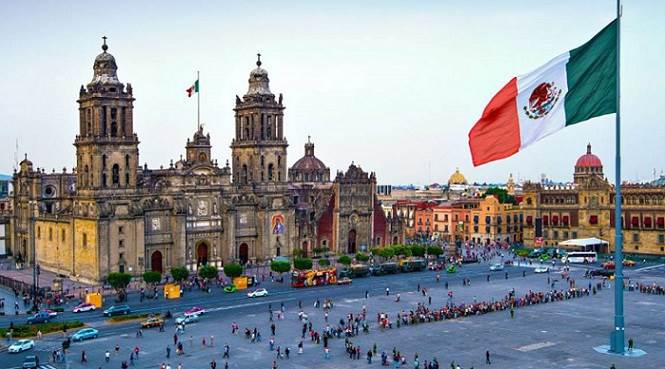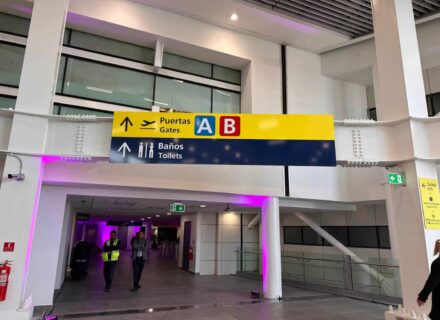Mexico City is a sprawling concrete jungle that was rather poetically founded by the Aztecs during the early 14th century. At the time, the city was on a small island in the middle of a vast lake. It has since dominated the area of said body of water with a gargantuan urban sprawl that has seen it become the largest city in North America. Constantly buzzing with exciting Latin vibes that excite and entice through the brightest colours, most flavoursome food and ancient history, Mexico’s capital is a vibrant festival for the senses. Museums filled with significant historical artefacts and world class art, mouthwatering cuisine served on every other street corner, immense architecture that echoes the city’s fascinating story, citizens that are unsurpassed in their passionately welcoming demeanour – the list of elements drawing travellers to this endearingly slow moving yet frenetic city goes on.
Mexico City’s Best Spots
A gargantuan metropolis sat in the base of a flat basin that was once home to a great lake during the era of the region’s original inhabitation, Mexico’s capital is home to so many lively districts and quirky neighbourhoods that it is a challenge to whittle them down to a list of specific favourites. A rainbow of archetypal colonial buildings line lively streets that play host to colloquial street food chefs and friendly locals who are only too happy to welcome travellers to their hometown. There is a tangible history throughout the city, depicting everything from pre-Columbian ages, through Spanish rule to the nation’s modern day Latin brilliance. Each section of the city seems to harness a unique personality of its own but as it would take an age to visit them all, here is a list of some of the most popular districts in Mexico City.
Centro Historico
Lying directly in the centre of the city and home to some of its most phenomenal treasures, Mexico City’s Centro Historico is a guaranteed stop on every travellers’ itinerary. At the centre of it all is the Zócalo, a large plaza directly next to which are three of the city’s greatest attractions: the National Palace (which contains some of Diego Riviera’s most significant pieces), the Templo Mayor Museum (site of the main temple of the Mexica peoples) and the Mexico City Metropolitan Cathedral.
Other top activities include admiring the instantly recognisable Palacio de Bellas Artes, listening to mariachi buskers at Plaza Garibaldi and feasting to your heart’s content on the plethora of street food options on offer. The colonial architecture dotted throughout the area accentuates the sense of historical significance that the city possesses.
Top Tip
Those with a sweet tooth are in for a treat when they visit Centro Historico, due to the bakery options on offer. Pastelería Ideal in particular, with its literal mounds of muffins, cakes and pastries, is the perfect place to grab yourself dessert or an on-the-go snack.
Condesa
One of the more fashionable areas in Mexico City, Condesa is known for its chic nightlife, boutique shopping and upmarket gastronomic options. Along the tree-lined streets of this bohemian section of the city are eateries and shopping options that wouldn’t be amiss in Europe’s trendiest neighbourhoods.
The colourful buildings add a quirky character that perfectly complements the easy pace at which life seems to flow here. There is no shortage of choice when it comes to picking a place to chill and watch the world drift by as you sip on a hot coffee or cool beer. It’s an excellent neighbourhood for taking the intensity of your trip down a notch or two whilst remaining close to the city centre.
Top Tip
Just to the northwest of La Condesa is Bosque de Chapultepec, a vast green space that in itself is great for an afternoon of exploring but the real highlight is at the northern end of the park in the form of the National Museum of Anthropology, which is considered by most to be the capital’s best museum by far.
Coyoacan
This quieter neighbourhood to the south of Mexico City’s centre was once an entirely separate village before it was engulfed by the expanding city’s borders, yet it has retained much of its laid back rural charm. The area was once home to world renowned artistic couple Freida Kahlo and Diego Riviera, whose influence still remains in the form of numerous galleries and the Museo de Frida Kahlo of course, which is located within the vibrant blue walls of their zany former home.
Coyoacan has all the hallmarks of a traditional Mexican neighbourhood – cute narrow alleyways and colonial buildings painted in an array of bright colours give the area a joyous aura that seems to resonate through everyone who visits. It is also home to a number of green spaces which provide visitors with a peaceful space to relax under the cooling shade that can so often be a necessity in the Mexican midday heat.
Top Tip
When visiting the marvelous Museo de Frida Kahlo make sure to buy your ticket online beforehand. Whilst tickets can be bought on the day, the queue tends to be a long and arduous wait, whereas those with pre-booked tickets get priority entry into the museum.
Roma
Mexico City’s Roma district has had a turbulent past, with both the ilk of its residents and their fortunes oscillating over time. Once a poor barrio, the area became more gentrified towards the end of the 20th century until the devastating earthquake of 1985 struck Mexico City, with Roma being one of the worst hit regions. Roma’s scarred streets caused its wealthier inhabitants to abandon their colonial homes, only for cheaper rent to lead to a mass immigration of creatives.
The history of this neighbourhood, which is the setting of the Oscar-winning film of the same name, has shaped it into a characterful pocket of Mexican treasure. The street art, bohemian cafes and retro Beetles lining the streets bolster the suggestion that the neighbourhood itself has been used as somewhat of a canvas on which its residents and visitors have both acknowledge its history and begun to sculpt a new one.
Top Tip
Immerse yourself into the art scene of Roma by musing over contemporary art at Galería OMR or viewing a film at arthouse cinema Cine Tonalá, located around the corner from the former home of Alfonso Cuarón, the director of Roma.
Xochimilco
One of the more fascinatingly obscure suburbs of Mexico City, Xochimilco ditches traffic-filled streets for a network of tree-lined canals teeming with traditional boats that burst with the brightest colours imaginable. Local Mexicans and tourists alike swarm to this bizarre region of the city to gradually drift along the waterways between artificial islands (or chinampas) that are used to grow all manner of flowers, fruits and vegetables.
The fantasy-like region has been growing crops in this manner for over a thousand years. It is a fascinating way in which to cultivate a piece of land that is rarely seen elsewhere in the history of our planet. Steeped in tradition but with a modern twist, travellers can float down the waterways listening to local mariachi bands with a mezcal or tequila in hand. A visit to Xochimilco is an experience that is at once fascinating and overtly Mexican.
Top Tip
One of Xochimilco’s more infamous draws comes in the form of The Island of the Dolls. After the island’s former owner became scared of the ghost of a girl who was said to have drowned nearby, he began to hang dolls from the island’s trees in an effort to appease her spirit. The result is one of the most harrowing visages on the planet in the form of an island coated in creepy, decaying plastic babies.
Teotihuacan
Whilst not technically in Mexico City, no visit to the country’s capital is complete without a trip to the legendary Mesoamerican site of Teotihuacan. As you walk down the main straight of the ancient city you can appreciate the colossal scale that it must have possessed at its peak. The archaeological site contains a number of significant buildings, most notably the Temple of the Sun and Temple of the Moon, two gigantic pyramids that are amongst the planet’s largest ancient pyramids outside of Egypt.
It is still not abundantly clear as to who built the impressive city, but exploring the 4km stretch of the aptly named Avenue of the Dead it becomes easier to visualise the towering structures lining the ancient boulevard painted in the deep reds traditionally used at the time of its construction. It is an image that is at once intriguing and intimidating, when considering the staggering number of human sacrifices which are though to have taken place here.
Top Tip
Whilst it may seem like a somewhat daunting task, climbing to the top of both of the site’s pyramids is a climb well worth undertaking. The views down the Avenue of the Dead from the Temple of the Moon are particularly spectacular as they give a greater sense of the immense scale of the ancient city.
Food & Drink in Mexico City
When it comes to the food scene in Mexico City it is difficult to know where to start. Most streets near the city’s centre are filled with the alluring scents of garnished meats grilling, enticingly spicy salsas, vividly fresh vegetables and other inexplicably delicious curiosities that cannot be found anywhere else. Most meals contain some manner of corn, beans and salsa combination that is sure to fill up even the most ravenously hungry traveller and somehow tastes entirely different from vendor to vendor. We recommend that visitors to Mexico City ditch the idea of meal times and eat as you go, simply following your nose whenever your stomach starts rumbling and embrace your inner gluttony. Here are some of the greatest street food classics that Mexico’s foodie haven of a capital has to offer.
Tacos
It doesn’t matter where you are in the city, you are sure to be within a stone’s throw of a taqueria (taco vendor) of some description, such is the popularity of what is sure to be Mexico’s favourite morsel. Tacos come in all kinds of varieties, from simple pork and salsa combinations to more obscure fillings like cow tongue and cactus. We suggest that you try as many combinations as possible, but here is a selection of some of the more popular varieties to get you started:
Tacos al pastor
Sliced from a grilled stack of glazed pork resembling a gyros and topped with sweet pineapple – probably the most commonly found taco flavour in Mexico City and utterly delicious.
Tacos de guisados
Not relating to a specific flavour or manner of spice, these tacos are filled with stewed meats or vegetables that have been slow cooking for hours until they fall apart and absorb all the flavour of the sauce.
Tacos campechanos
Thinly sliced beef that has been expertly grilled is combined with diced chorizo style sausage to create one of the tastiest meat combinations found on earth.
Tacos de suadero
Perhaps not a taco for the more squeamish traveller, multiple beef cuts (from almost all parts of the cow) are part-grilled, part-fried in a succulent broth until melt-in-the-mouth tender.
All tacos are served with a selection of salsas, lime wedges and other condiments so that you can choose your preferred toppings and mix it up from taco to taco to suit your mood.
Quesadillas
Despite their name, quesadillas in Mexico City don’t necessarily contain cheese. In order to make these delicious savoury snacks, a corn tortilla is griddled and folded in half, enclosing the filling in the centre. These fillings can vary from meaty options like longaniza (a Mexican sausage that is fried until it has a satisfying crunch) or chicharrón (much like pork crackling) to veggie options such as mushrooms or grilled squash blossoms. You will usually be asked whether you would prefer green or red salsa – although there is no given rule as to which is spicier – before it is finished off and you can tuck in!
Tamales
Typically eaten for breakfast, tamales are made by steaming corn based dough stuffed with meat and salsa or mole inside a corn husk, resulting in a hearty meal that perfectly sets you up for the rest of the day. Tamales have been around for millenia in Mexico and its neighbouring countries and to this day remain easily locatable throughout most of Latin America. Tamales are also available in a sweet variety, where sugar, cinnamon and vanilla are added to the initial corn mixture to give the tamale a sweeter taste. This version of a tamale can also be enjoyed as a dessert for those that have space remaining in their stomachs post-mealtime.
Tortas
Essentially Mexico’s answer to a sandwich, tortas consist of freshly baked crusty bread sliced in two and all manner of fillings being placed in the middle – chorizo, breaded meat, ham, veggies, potatoes and/or cheese to name just a few options – before being topped with the customary spicy salsas found throughout the national cuisine to create one absolutely delicious concoction. Tortas are typically served at lunch time along busy streets of people searching for a quick bite to eat.
Tlacoyos
Ovals of blue corn dough are filled with a mixture of savoury snacks before being griddled until lightly crisp on the outside and the delicious filling starts bubbling out of the middle. Classic tlacoyo fillings typically consist of mushrooms, chicharrón, refried beans and soft cheese, with nopal – a delicious type of Mexican cactus – and salsa added as toppings. Tlacoyos offer a brilliant alternative to other popular Mexican street food options and their small size means that you can keep sampling new flavours until you’re too full to eat anymore.
Churros
Fast becoming a global craze, churros are sticks of sweet dough that have been deep fried before a light coating of sugar and cinnamon is added. Ideal as either an on-the-go snack or as a pudding, they are typically served with some form of chocolate sauce or sweet drink, in the form of a hot chocolate or milkshake, so that you can dip to your heart’s content.
Tequila & Mezcal
Not a street food per se but certainly too Mexican to leave off the list, tequila is distilled using juice from blue agave plants. If the drink isn’t at least 51% blue agave it is in fact mezcal, which can be made from all manner of agave plants. As such, there isn’t a particularly notable difference in taste between the two spirits and tequila’s less renowned cousin is starting to grow in popularity across the world. Mezcalerias (mezcal bars) are very common throughout Mexico City. Try drinking these spirits the local way – straight from the shot glass without any lime or salt.
Getting Around Mexico City
By far the best form of public transport in Mexico City is the underground metro train system. Second only to New York’s subway in terms of North America’s largest metro systems, the trains cover an extensive proportion of the city, with stops near almost all of Mexico City’s major sites. Being very affordable too, the metro is a sensible choice of transport over the often confusing bus system. However, reports of pickpocketing and muggings on the metro aren’t uncommon so travellers should always keep their wits about them.
Alternatively, taxis are very common throughout the city and advisable after sundown in shiftier areas. Apps like Uber also operate in Mexico’s capital, which provide travellers with a feeling of extra security.
Alternative things to do in and around Mexico City
Considering the amount of land covered by the far-reaching borders of Mexico City’s bustling neighbourhoods, there is sure to be something to suit the tastes of anyone looking to explore the city’s criss cross of meandering streets. Not only that, but just beyond the capital’s outskirts lie numerous activities that could keep any genre of traveller entertained for months on end.
Watching a bout of lucha libre
Having been introduced in Mexico during the 19th century, wrestling here has taken on a quintessentially Mexican feel. In lucha libre, wrestlers don flamboyant outfits that are almost as dazzling as the show that the contenders put on for the crowd. The most important part of a luchador’s outfit is their mask, which is occasionally removed at the end of an important fight to the ultimate shame of the loser.
Lucha libre fights can attract crowds of thousands all cheering on their favourite fighters, a lot of whom reach genuine celebrity status for their exploits in the ring. The fights are staged and always have an almost comically dramatic backstory but with the immensely impressive choreography and athleticism of the fighters, as well as the electric atmosphere that fights whip up, it is almost impossible not to get swept up in it all. In order to watch a bout of this theatrical Mexican tradition, head to either Arena Mexico on a Tuesday, Friday or Sunday, or see when a fight is on in Arena Coliseo.
Ambling through the La Lagunilla Flea Market on a Sunday
Although the market here is open daily, only Sundays see it hit its full potential when the surrounding streets are suddenly swimming with individuals selling a truly unpredictable assortment of second hand trinkets. Shoppers can buy anything from motorbike parts and antique toys to second hand clothing and live chickens.
Whether or not you wish to buy any second hand Mexican family merchandise, the market is a thoroughly interesting place through which to wander. The fact that all the items on offer are heirlooms and knick-knacks from the homes of local families means that the market provides an interesting angle from which to consider the daily lives of Mexico City’s citizens.
Climbing the “hill” at Cholula
The perfect day trip from Mexico City, Cholula is full of picturesque colonial churches, but none are quite as noticeable as the Iglesia de Nuestra Señora de los Remedios which sits upon a “hill” in front of the colossal Popocatepetl volcano which looms against the skyline behind. Despite its initial appearance, the hill on which the church sits is in fact the ruins of an ancient pyramid that has been engulfed in vegetation over time. A fact that went unnoticed by the Spanish who constructed the church during the 16th century.
This architectural metaphor of the unsympathetic Spanish invasion of Mexico isn’t the only draw of this comparatively diminutive city. Travellers can marvel at typically colourful colonial buildings, get lost in local markets or visit the recently opened Museo Regional Cholula to delve deeper into the region’s history.
Tasting some of Mexico’s more exotic flavours
Whilst Mexican food has become a global phenomenon, with tacos, quesadillas and churros available to buy in just about every other country on the planet, some traditional delicacies have proven too strange to be adopted by Mexican restaurants across the globe. The adventurous eaters amongst you should see a trip to Mexico as the perfect opportunity to sample some of these oddities.
Some of the more obscure food options include escamoles (ant larvae), gusanos de maguey (caterpillars), sal de gusano (ground worm salt) and tacos containing eyeballs, brain or intestine. In some cases a reluctance to sample these foods is understandable, but with an open mind and closed eyes many of these strange dishes can be appreciated by even the fussiest eater.
Celebrating Dia de los Muertos
If you plan to visit Mexico City at the end of October or start of November make sure to take part in the legendary Day of the Dead celebrations. Funnily enough the parade that makes its way through Mexico’s capital is one of the nation’s more contemporary traditions, having been inspired by the opening scene of 2015 James Bond film Spectre, before which the city’s main parade did not exist.
Despite the parade itself still being in the juvenile stages, Day of the Dead celebrations have occurred in the Latin American country since pre-Columbian times. A celebration of the memory of passed loved ones, revellers hit the streets dressed as skeletons in a rainbow of colour typical of modern Mexican culture and pay respect in a burst of joyous festivities. Regardless of whether or not they consider themselves to be spiritual, travellers are sure to be caught up in the energetic jubilance of this annual festival.



